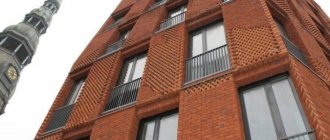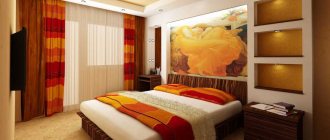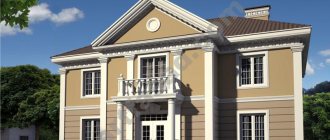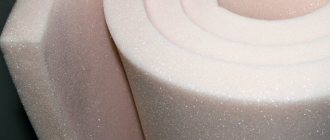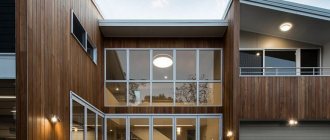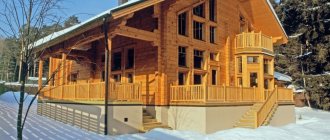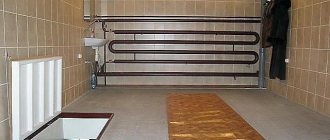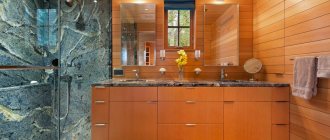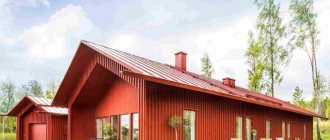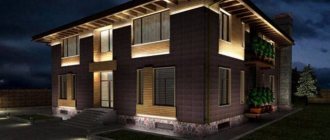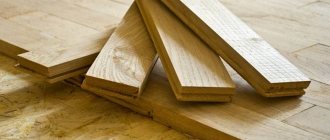Help the site, share with friends:
Exterior wall decoration is an important part of the design of any building. After all, the facade of the house is the business card of the owners. It reflects their preferences and forms the first impression of the home as a whole. External finishing, in addition to being decorative, also serves as insulation and also plays the role of protecting load-bearing walls from the effects of temperature changes and natural precipitation. In this article you will learn how to decorate the facade of a private house.
Nowadays, there is a huge amount of building materials that can be used for exterior decoration of a building. Before you begin work on decorating external walls, you need to carefully study the positive and negative qualities of all finishing materials and decide what final result you plan to get.
The external decoration of a private house also depends on the design of the interiors - it is necessary that there is harmony between them. Only then will the house look not just like a structure made of stone and concrete, but a comfortable and cozy home in which you will want, as they say, to live and live well and make good money.
In addition, the choice of finishing material is influenced by:
- selected façade design style;
- climate;
- budget for construction work.
External finishing of facades with stone
The owners of this house believe that it is better to clad the house with natural stone.
Natural stone is one of the most durable building materials. Exterior decoration made from it, if not eternal, will definitely serve for several centuries. However, laying fragments of natural stone, especially wild, natural stone, requires considerable effort and special skills.
This is what finishing from different types of granite looks like
And this is what limestone cut into tiles looks like on the façade:
Marble is used less frequently for facade cladding, as it is less resistant to moisture and temperature changes than, for example, granite. However, if you want to turn your home into a real glittering palace, you can use, at least partially, marble finishing.
An intermediate option between limestone and marble is travertine:
And this is a more budget “version” of travertine - Dagestan stone:
Porous shell rock of a warm sand color is also perfect as a facing material:
Over time, its shade becomes darker, but to avoid this, you can coat the surface with a protective varnish. If you are against using natural stone, you can clad your house with artificial tiles that replicate the texture of natural material:
Another option is an easy-to-install artificial flexible stone, which is acrylic slabs with an adhesive base:
Modern cladding of the facade of a house, which material is better - comparison of options
The variety of options for finishing house facades with modern materials complicates the choice, so it is important to first analyze their range and decide on priority criteria.
| Material name | Key Benefits | Flaws |
| Plaster: mineral; acrylic; silicate; silicone. | Aesthetic appearance Breathable coating | Possibility of damage from mechanical impacts |
| Stone: natural; artificial. | Naturalness Environmental safety High resistance to external influences | High price Requires installation skills |
| Facing brick: clinker; ceramic; hyper-pressed; silicate. | Safe Frost-resistant With high decorative qualities | A reliable foundation is required Careful docking |
| Porcelain tiles | Excellent strength Resistance to any weather conditions Durability | Significant weight High cost |
| Ceramic facade tiles | Good decorative qualities, durability Low price | The need for careful preparation of the base You need to have laying skills Fragility of the material |
| Decorative siding: vinyl; wooden (larch); metal. | Easy installation Low price Good decor | Some species have a short service life Poor resistance to ultraviolet radiation |
| Sandwich panels | Environmental safety Quick installation Good noise insulation Durability | Joints may freeze |
| Ventilated facade | Long service life High thermal insulation performance Affordable installation | Condensation may form in gaps |
Even a brief overview analysis allows us to draw certain conclusions. More detailed information can be found in the article in the descriptions devoted to specific types of facing varieties.
Facade cladding with porcelain stoneware
Porcelain tiles are frost- and wear-resistant tiles, which contain clay baked at ultra-high temperatures and metal compounds. For facades, both thin porcelain tiles (Arkhskin, Kerlit, Laminam, etc.) and ordinary ones are used. Thin, just like regular material, it can be installed with glue directly on the prepared surface or on a curtain wall system. The latter option is often used in the construction of high-rise buildings and public buildings, but can also be used for cladding private houses. Regular porcelain tiles:
And thin porcelain tiles look richer due to the wide format of the slab:
Or like this:
Finishing materials for facades of private houses - analysis of types of facade cladding
The construction market offers a fairly extensive range of finishing materials aimed at cladding private houses. This allows you to choose not only the color palette of the future facade of the house, but also take into account your own preferences and financial capabilities.
Plaster
Facade surfaces finished with decorative plaster acquire a stylish, smooth appearance. Several varieties of this finishing material are used.
Mineral plaster
The mixture for the production of a mineral type of plaster is made on the basis of white Portland cement, supplemented with marble chips or quartz sand and lime hydrant. Water-repellent additives and plasticizers are included.
It is sold in the form of a dry powder, which has a low cost. This is one of the advantages influencing the choice of such material. The resistance of mineral plaster coatings to temperature changes is highly rated. It is not inhabited by fungus. The mass prepared in accordance with the instructions is easily applied to prepared surfaces.
Mineral plaster, when applied correctly, forms a smooth surface
The disadvantage is the appearance of cracks in the coating due to vibration, short service life - about ten years, the need to prepare the solution yourself, and high labor costs when applying the composition. The limited range of colors is also considered a disadvantage, although if desired, the wall can be easily painted after the coating has dried.
Acrylic plaster
A special feature of acrylic plaster is the use of synthetic resins as a binder. The finished decorative finishing of facades made from this material is plastic and durable, and has the advantage of being able to “breathe”. Plastered surfaces dry quickly after rain or snow, which ensures the durability of the coating. It is frost-resistant and does not deform even with significant temperature fluctuations. By purchasing a ready-made white composition, you can choose different shades by introducing dyes.
A durable coating of acrylic plaster will protect the walls of the house for a long time
The disadvantages include the rapid accumulation of dust, which should be removed with a stream of water from a hose. Work involving open fire should not be carried out near surfaces finished with acrylic plaster to avoid fire.
Silicate plaster
To produce silicate plaster, a solution of sodium and potassium silicates is used, which is heat treated in an autoclave. In order to impart the necessary characteristics, plasticizers, mineral fillers, and coloring agents are added to the mixture. Among the advantages is the possibility of using silicate plaster on different planes. It fits well on brick, concrete, and drywall.
The decorative cladding of facades made using silicate plaster is “breathable”, which is important for ensuring the safety of wall structures. It does not deform and does not shrink, is highly resistant to various atmospheric influences, is fire resistant, and does not attract dust. Usually sold ready-made.
Silicate plaster is easy to apply, forming a stable coating
The main disadvantage is the insufficient plasticity of the finished coating, which is why cracks appear on the facades over time.
Silicone plaster
The basis of silicone plaster is silicone resins, which determine the high elasticity of the material and give it outstanding water-repellent properties. No cracks appear on the plastic coating, the bright shade remains saturated, despite prolonged exposure to sunlight and precipitation. Due to high vapor permeability, the walls of the house retain their performance characteristics for a long time. Silicone plaster coating is not susceptible to mold growth.
Thanks to its excellent characteristics, silicone plaster forms strong, durable coatings
There are practically no disadvantages to this unique modern type of plaster. The only drawback may be the higher cost compared to analogues.
Natural and artificial stone
Among the indisputable advantages of natural stone used for facade cladding are environmental safety, reliability, practicality, and durability. With its help, the building receives a prestigious, noble external image. In winter, such a house will always be warm, and in summer it will remain cool.
Natural stone will turn even a modest structure into a luxurious, majestic building
Among the disadvantages, the most significant is the heavy weight, which requires a reliable foundation. This material is also quite expensive. A worthy replacement can be artificial stone, which is easy to install, can be processed well, and does not require careful leveling of the rough surface. An important advantage is the aesthetic appearance. Artificial stone no less reliably protects walls from precipitation and shows high resistance to temperature changes. This is an environmentally friendly non-flammable material.
Artificial stone in facade cladding looks dignified and noble
Facing brick for the facade showing finishing options
There are several varieties of bricks designed for reliable finishing of facade surfaces. This building material has the ability to create a unique outdoor decor in any color combination.
Clinker brick
For the production of clinker bricks, a special kaolin type of clay is used, which is brought to complete baking during the firing process. This method ensures high strength of clinker brick cladding, which does not collapse even after decades under the influence of frost, thaw, precipitation, and winds. This material perfectly protects walls and has a stylish appearance reminiscent of ancient buildings.
The magnificent external decor will remain throughout the entire operational period
The shades of brick depend on the inclusion of various substances in the clay. For example, iron or aluminum oxide provides, after firing, an expressive cherry tint of varying degrees of saturation, reaching a dark purple tone. Carbon monoxide gives achromatic shades - black, gray. All characteristic brick color variations are found. The decor is preserved throughout its long service life.
A variety of shades of clinker bricks allows you to satisfy the most demanding tastes
Disadvantages include rather complex installation work, high cost, and the need for additional thermal and sound insulation.
Ceramic brick
If you need to choose options for the exterior finishing of a wooden house, then you should pay attention to ceramic bricks. The base material for its manufacture is clay of a fine, homogeneous fraction. The finished facing material has good strength, withstands mechanical stress without damage, is resistant to ultraviolet radiation, and has high frost resistance.
Ceramic brick cladding has a timeless decor and constantly remains in a leading position
During the production process, special requirements are placed on the front surface, which can be wavy, rough or smooth. The cladding is “breathable”, protecting the walls from destruction. By adding coloring compounds to clay, different shades of the material are obtained.
Hyperpressed brick
Being a relatively new finishing material, hyperpressed brick is of interest due to its outstanding characteristics. The raw material for it is a cement-lime mixture with some fillers. For example, they may be blast furnace slag, screenings of granite, shell rock and other natural varieties, on which the color of the finished finishing material depends. Hyper-pressed bricks are produced using the semi-dry pressing method. The raw materials are pre-crushed. With slight moisture (water in the mixture is only about 10%), bricks are formed from it under high pressure in special matrices. Then they are additionally kept in a steam chamber to ensure complete hydration of the cement.
Among the advantages of hyperpressed brick are moisture resistance, strength, non-flammability, frost resistance, easy installation, durability, and environmental safety. Attracts a wide range of colors. If you plan to work on finishing with this material, then it is worth looking at the entire range, since it is possible to choose different textures of the front surface and various shapes of the material.
Among the advantages of durable finishing material is its unique texture and color palette.
Among the disadvantages is the fairly high weight, which requires a reliable foundation. Due to the high density, additional measures must be taken to ensure thermal insulation. Also, the cost of such bricks is quite high.
Sand-lime brick
Sand and lime are needed to make sand-lime bricks. From these components, with the addition of a standardized amount of water, a silicate mass is obtained for further formation of bricks from it under pressure.
The advantages are high thermal insulation characteristics, good noise insulation, strength, high density, variety of colors. The ease of installation ensured by precise geometric dimensions is attractive.
Decorative characteristics are an important motive for choosing sand-lime bricks for finishing
The disadvantages of sand-lime brick, when compared with its ceramic counterpart, include lower fire resistance, water resistance and frost resistance. If the sand-lime brick finish often gets wet, then chips, pores, cavities appear, and dirt and dust begin to accumulate.
Porcelain tiles for facade
The basis of porcelain stoneware, in addition to white clay, is feldspar, quartz sand, and water. The mixture undergoes high-temperature firing and then pressing. The result is monolithic slabs.
Ceramic granite, blessing
Due to its texture, it looks prestigious and impressive on the facades of any buildings. This material does not deform under the influence of various aggressive substances and moisture, frost, and hot sunlight. It perfectly protects walls and is one of the most durable facing varieties.
Porcelain stoneware finishes look stylish and modern
The disadvantages are the high cost and complexity of installation, which requires certain qualifications of the workers performing the finishing of the facade. One of the disadvantages is the high weight of porcelain stoneware slabs.
Ceramic tiles for finishing the facade of a house
Ceramic facade tiles can be called the leader of facing materials, thanks to environmental safety, presentable appearance, and a wide range of composition and color solutions. When installed correctly, tiles can easily transform the appearance of a home and reliably protect it from various atmospheric influences.
Among the rich assortment, you can choose products of varying prices, ranging from budget options. An important advantage of ceramic tiles is their long service life, light weight, fire resistance, water resistance, preservation of color shades, and lack of deformation when exposed to negative temperatures.
Ceramic tiles create a coating with different stylizations, for example, like brick
It is necessary to take into account such disadvantages of tiles as increased fragility and fragility, so all work is carried out carefully. Also be careful during transportation.
Decorative siding
When deciding how to decorate the facade of a house, many turn to the assortment of siding, which has a varied color palette and varies in cost depending on the material.
Vinyl siding
Cheap and visually attractive vinyl siding, aimed at cladding the facades of houses, has certain advantages. You can choose options stylized as logs, timber, or stone. The assortment includes various colors and patterns. The weight of this material is very low, you can easily install it yourself. As a result, the most unpresentable house takes on a surprisingly aesthetic appearance.
The external appearance of your home can be achieved with inexpensive vinyl siding.
Attention! But it should be borne in mind that the material has serious disadvantages. In severe frosts, vinyl cracks and becomes brittle. If the weather is very hot, the panels soften and become deformed.
The color of the material gradually fades in direct sunlight. It is necessary to take into account the short service life and the need for careful calculation of siding and its components.
Related article:
DIY siding installation. Step-by-step photo instructions for dummies on installing siding with practical tips in a separate publication on our portal.
Wood siding
Wood siding, the predecessor of all other types of similar finishes, has not lost its popularity. To manufacture modern products, a wood cellulose mixture is pressed when heated, which makes the panels durable. Additives are added to improve performance characteristics. The raw materials are first purified from harmful impurities and resins, which makes wood siding an environmentally friendly material. Thanks to its natural structure, its coating looks cozy and natural.
Wood siding gives your home a cozy, homey look.
Among the disadvantages is the need for periodic treatment with compounds that protect against fire, mold and insect repellents. Also, wooden cladding requires painting, as it periodically fades in the sun. It is not recommended to cover the walls of private houses made of fiberboard, foam or fiberglass with wooden siding.
Metal siding
If we compare metal siding with its analogues, it is the most resistant to natural influences and has a service life of 30 years or more. The material is durable, withstands shock loads well, and does not become brittle when heated and cooled. All dirt can be easily washed off with a stream of water from a hose. Metal siding is rot-resistant and cannot be damaged by rodents and insects. This material is fire-resistant and does not melt in the presence of an open flame nearby. Does not fade when exposed to sunlight.
Metal siding, stylized as timber, is a reliable covering for the house
Disadvantages include the possibility of rust due to exposure to moisture and higher cost. Cutting requires a special knife, and installation cannot be carried out without professional skills. When attaching the cladding, it is mandatory to install thermal insulation.
Sandwich panels
Thanks to a three-layer structure, including a metal or polymer shell located on both sides and insulation between them, sandwich panels have excellent thermal insulation qualities. Mineral wool, penoplex or polyurethane foam are used as insulation.
Thanks to their three-layer structure, sandwich panels reliably insulate the walls of the house
This is a worthy material for finishing the facades of private houses, the positive characteristics of which are quick installation, low weight, good sound insulation, and environmental safety. An important factor is the affordable cost. After proper installation on a frame (wooden or metal), sandwich panels serve flawlessly for a long time.
The downside may be the possibility of freezing of the joints if the installation was carried out incorrectly.
Ventilated facades
Multi-component ventilated facades protect walls when temperatures drop and extend their service life. They are a system with special gaps that ensure ventilation of the insulation. It is recommended to use galvanized or aluminum profiles for the frame.
The advantages of ventilated facades are their long service life, which is at least 50 years. In winter, they retain heat well, are non-flammable and environmentally friendly. When temperature changes occur, cracks do not form on the surface. They are attracted by simple installation techniques that can be carried out at any time. If necessary, the cladding can be easily dismantled.
Ventilated facades have a varied surface texture
The downside of a ventilated façade is the possibility of condensation appearing between the wall and the insulation if the installation was carried out incorrectly. As a result, the walls begin to freeze, and moisture forms on them, reducing their service life.
Façade cladding with fiber cement panels
You can clad the house with fiber cement panels “like stone” or “like wood”. Such panels consist of 90% cement and 10% filler, which determines the texture. The slabs are mounted using a “dry” hinged method, on insulation, without the use of adhesive solutions. Fiber cement boards of domestic production: LTM and LATONIT, or others.
External cladding of the house with Japanese panels
The use of cement-bonded particle boards (CSP) “like bricks”
You can decorate the outside of the house with siding
Siding is the same hanging panels with different textures that imitate natural materials. But, basically, siding imitates wood. Siding is distinguished by the composition of the raw materials from which it is made. Fiber cement siding looks like this:
Metal:
From PVC materials:
In our country siding “under a log” is called a blockhouse.
Façade cladding with wood
If you decide to use natural wood for finishing, you can choose one of the options.
Lining
It is better to use larch that is resistant to the external environment.
Wooden blockhouse
Facade with beveled slats (“planken”) under the blinds
If you do not want to use natural wood, you can, as an option, clad the façade with wood-look panels.
Panels imitating natural wood
HPL panels on the facade
HPL plastic on the facade of a private house
ROCK panels
External façade cladding imitating stone or brick
You can choose cladding without insulation or directly with thermal insulation. Don’t know what to use to clad the façade of a house if you need panels without insulation? Pay attention to the hanging altfacade slabs. This is what the version with the tavertine effect looks like:
How to make the façade of a house, if you need it right away with insulation, choose thermal panels. For example, for clinker:
Wood paneling
Wood is considered an excellent thermal insulation and environmentally friendly material. Most often, oak, cedar, and pine are used to make wooden panels.
Note! Sliding gates with auto mechanism
The positive aspects of wood are its strength and resistance to precipitation. The disadvantages include the need for special care: the wood must be treated every year with special compounds to protect it from pests.
Combined facade
If you can’t decide how best to decorate the outside walls of your home, consider combining different materials.
Combined plaster on the facade
Wood plus brick
Stone effect tiles and wood effect panels
Planken plus polished limestone
Review of prices for facade materials for exterior finishing of a house
When deciding how to cover the outside of a house cheaply and beautifully, you should analyze the prices for the most popular facing materials.
| Material name | Price per m², rub. | Cost of turnkey work including insulation per m², rub. |
| Plaster | ||
| Mineral | 350−750 | ˃850 |
| Acrylic | 1600−1905 | ˃2100 |
| Silicate | 2600-2615 | ˃3100 |
| Silicone | 2406−3900 | ˃3500 |
| Stone | ||
| Natural | 1400−2750 | ˃7340 |
| Artificial | 550-2350 | ˃4550 |
| Facing brick | ||
| Clinker | 1250−2650 | ˃2600 |
| Ceramic | 400-800 | ˃1400 |
| Hyper-pressed | 665-1250 | ˃1700 |
| Silicate | 280-350 | ˃1000 |
| Porcelain tiles | 630-1850 | ˃3680 |
| Ceramic facade tiles | 958-2350 | ˃1700 |
| Decorative siding | ||
| Vinyl | 185 | ˃750 |
| Wooden (larch) | 590-1950 | ˃2000 |
| Metal | 450-600 | ˃1550 |
| Sandwich panels | 600-1800 | ˃3100 |
| Ventilated facade | 1150-1500 | ˃650 |
Among the improved varieties of new generation cladding, it is worth noting Russian-made thermal façade panels, the price of which varies from 2050 to 7000 rubles. per m2. This material is a gas-filled plastic with a decorative surface made of mineral chips or tiles of different colors and textures.
A new generation finishing material - thermal panel - has a varied decor of the front surface
Choosing the right type of finishing for your own home is a serious job that requires a comprehensive analysis of many factors. We will be interested in your experience, express your opinion, share tips and recommendations, ask questions in the comments.
Related article:
Facade panels for exterior decoration of the house. From this publication you will learn all about the types of facade panels, materials, advantages and disadvantages.
You can cover the façade of a private house with stained glass structures
Stained glass makes the house airy and elegant. Glass entrances look great:
Stained glass "second light":
Glass facade of a private house
Winter gardens with stained glass glazing:
The cheaper it is to sheathe the outside of a house
If you want to cheaply decorate the facade of your house, choose plaster or fiber cement.
Gypsum plaster:
Fiber cement facade:
Interesting design idea on the facade
Inexpensive finishing of the facade of a house can also be obtained if you choose panels: for example, with or without insulation, siding or artificial stone:
Artificial stone panels can be very affordable
It is cheaper to decorate the facade with Alt-panels than with thermal panels with insulation
You can use dark-colored wooden slats on the plaster, imitating “Fachwerk”
Requirements for facade finishing
The basic requirements for finishing facade surfaces are regulated by the Code of Rules 71.13330.2017. Based on this document, it is prescribed to use materials in the form of mastic or glue of class C1 (on the lower floors) and C2 (above the first floor) for fixing facing slabs that require an adhesive layer.
Reliable fixation of tiles requires proper selection of adhesive material
If the exterior of the house is decorated with natural stone, then the slabs are first washed and dried. For artificial materials, additional moisture is not required. When the area of the slab material is over 900 cm², the adhesive solution must be applied both to the wall and to the back surface of the material. When using artificial slabs or natural stone with a thickness above 12 mm, fasteners are installed.
Fastening elements allow the cladding to be performed efficiently and in accordance with the Rules
Note! In cases of using facing products with different colors and textures, you must first develop a pattern selection scheme. During the work process, deposits of mastic and adhesive solutions are immediately cleaned, preventing them from hardening. The seams must be the same width.
The rules regulate the maximum deviation values of certain parameters when performing façade cladding.
| Type of coated surface | Maximum deviations, mm | Maximum unevenness of the lined surface, measured with a two-meter strip, mm | ||
| Seam width | Vertical cladding surfaces for each meter of length | Location of seams from horizontal and vertical for each meter of length | ||
| Mirror | ±0,5 | 2 | 1,5 | 2 |
| Polished | ±0,5 | 4 | 1,5 | 2 |
| lumpy, dotted, grooved | — | 8 | 3 | 4 |
| Sanded | — | 3 | 3 | 4 |
| Rock texture | ±2 | — | 3 | — |
| Made from artificial stone and granite | ±0,5 | — | — | — |
| From marble | ±0,5 | — | — | — |
| From glass-ceramic, ceramic and other products | ±0,5 | 2 | 21,5 | 32 |
House facade decor
To improve the facade of your home, you can use simple design techniques. Decorative stone inserts in the plinth area:
Decor of the entrance area, corners and windows:
Contrasting gypsum board inserts plus stucco molding:
Beautiful exquisite facade
Foam decor in half-timbered style:
Facade painting:
Decorative shutters:
You can decorate the entrance group with railings, a canopy, and interesting entrance steps.
A canopy over the entrance decorates the facade
Stone steps complete the appearance of the facade
You can equip a terrace and glaze it, trim it with wood or decorate it in a Mediterranean style.
When choosing what to cover the facade of a house with, it is better to be guided by the climatic conditions of the area in which the house is located, the requirements for the stability of the finish, as well as individual stylistic preferences.
If you have decided, choosing methods for finishing facades is not a problem.
Similar articles
- Check out the new product: brick-look clinker panels
One of the advantages
of cladding the façade of a house
with brick-look slabs is the ease of installation. Read more - How can you decorate a house made of foam blocks, and what…
Facade
cladding .
First you need to decide how the facades of houses
made of foam blocks are finished. Read more - Panels for finishing facades of private houses
Panels for finishing
the facades of
private
houses
.
...
All that remains is to transform the clinker tiles into clinker panels for
cladding the facades
. Read more - Which is better: siding or plaster
Cladding the facade of a house
: choosing which material is better.
At the stage of developing a private house
, the customer must determine which... Read more - Cladding the facade of a house with corrugated sheets - simple...
Cladding the facade of a house
with corrugated sheets requires special effort when finishing the openings of windows and doors. Read more - High-quality cladding of the plinth
Cladding of the facade of the house
: choosing which material is better.
At the stage of developing a private house
, the customer must determine which... 1. Read more
How to additionally decorate the facade of the house?
If your goal is a beautiful, but moderately bright home, try to avoid extravagant decor for the facades.
A sign with the house number will be a wonderful decoration for the exterior - the numbers on it can be printed in an unusual font or colored paint. A mailbox, a rug at the front door, lighting - all these little things create a certain character and mood. Before the New Year holidays, decorate your home with lights and other holiday decor. And don’t forget to use photos of finished projects for inspiration when updating the facade of your house. If you are just looking for ideas for renovation and improvement or already know for sure that a house is your option, we have collected for you 1,235,469 photos from real projects of interior designers, decorators and architects from Russia and around the world, including such proven professionals as Pustoshinsky Vitaly and Luka Marmi. The beautiful houses in our photographs are the best examples of competent design and layout in different styles and colors. If you like any design option, for example the house from the second photo, you can contact the author and order the ideal design project for yourself. See our photo gallery, look for inspiration and professionals, and you will see why Houzz is the best resource for apartment and home interior design, renovation, home construction, architecture and landscape design.
